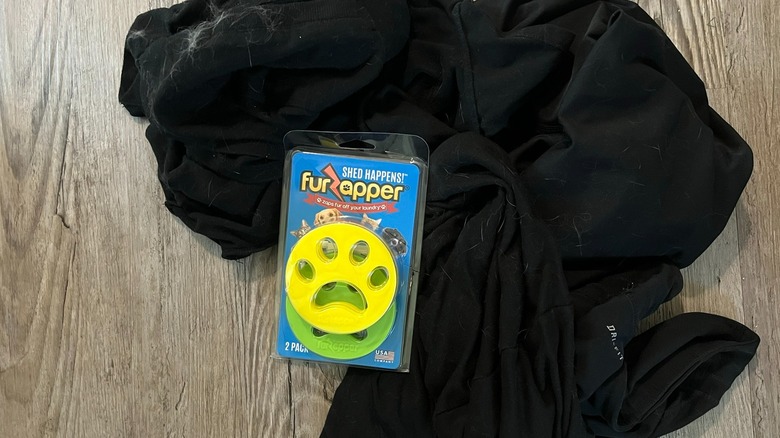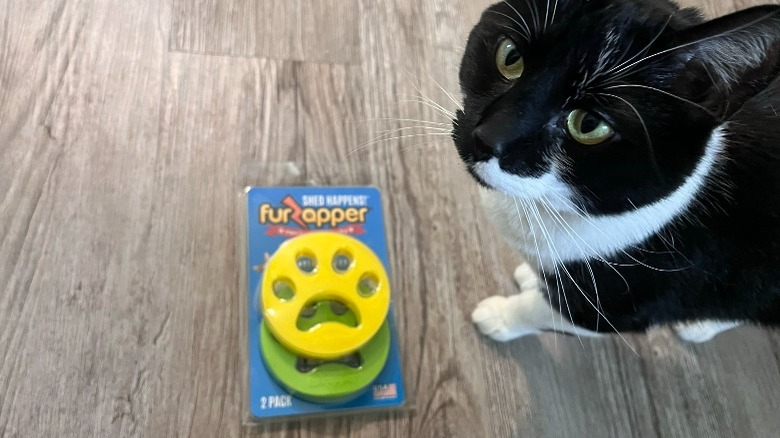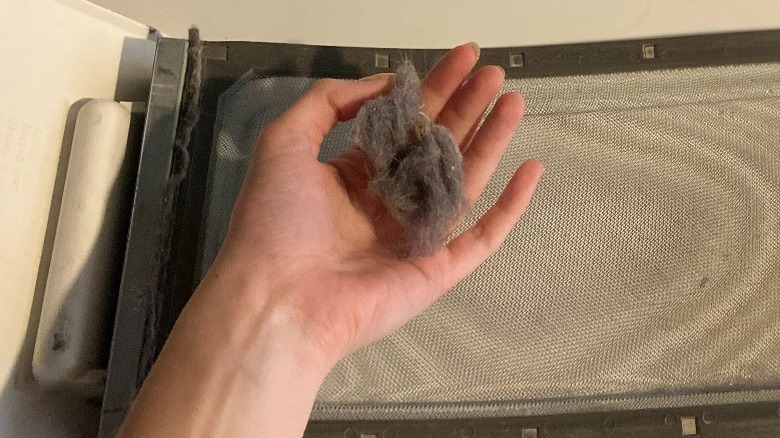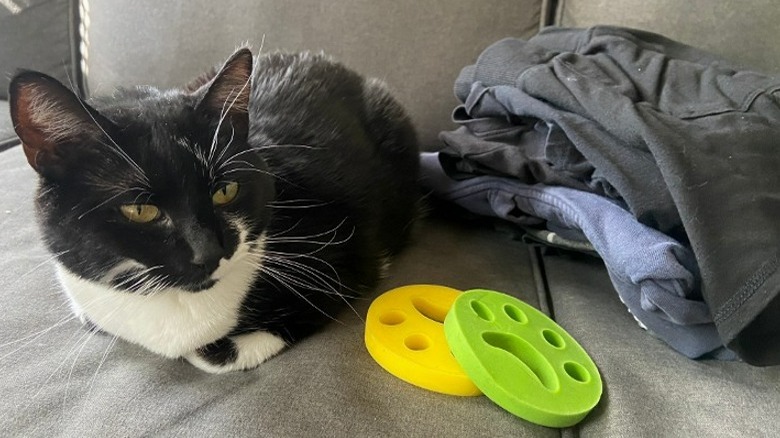We Tried Shark Tank's FurZapper For Laundry And Encountered A Hairy Problem
We may receive a commission on purchases made from links.
Although we love our furry friends, pet hair can wreak havoc on almost any outfit. If you are particularly fond of large fluffy animals and black clothing, you know the struggle is all too real. The FurZapper, which was introduced on Shark Tank by Harry Levin and Michael Sweigar, is a laundry product that claims to remove pet hair in the washer and dryer. The FurZapper was first thought of by Levin when he discovered the properties of tacky silicone in the wash. Not only do the disks claim to remove pet hair, but also dander and lint for speck-free clothing. Unlike what you might expect, the FurZapper isn't supposed to collect the hair. Instead, it pulls them from the clothes and releases them into the water or dryer vent.
In our apartment, we live with just one furry friend. However, she is unsuspectingly full of loose hairs that quickly attach themselves across any clean shirt. Getting rid of the fur is a chore, and normally, running them through the laundry only spreads the hair around. So, we often end up breaking out the lint rollers as well. We hope that the FurZapper will, at least, coax some of the hair out of the clothes and down the drain or into the lint trap. Let's see!
Gathering our materials
After purchasing a two-pack of the FurZapper on Amazon for approximately $13, all we had to do was collect our most fur-covered clothes and some laundry detergent to test them out. We used our bottle of Tide Free & Gentle that we purchased from Walmart for about $6, and no fabric softener or dryer sheets as instructed by the FurZapper packaging.
While waiting for our FurZappers to arrive in the mail, we spent three days creating a pile of clothes with visible cat hair on them. Of course, many of these pieces of clothing were black or darkly colored, which always seems to be the case, despite our kitty being a mostly-black tuxedo cat. Then, we brought the small pile down to our basement laundry room and put them in our top-loading washer. Before starting, we also made sure to set our Kenmore washing machine to its regular washing cycle with the water temperature set to warm, and we cleaned out the lint trap in our dryer.
Putting the FurZapper to the test
To test the FurZapper, we measured out our laundry detergent, unpacked our pet hair-removing product, and tossed both in the wash. The next step was as simple as pressing the button. Once the load was over (it took a little more than an hour), we inspected the clothes and FurZappers to see if there was any noticeable change. The yellow and green disks were intact and mostly hair-free, but the clothes' wetness made it difficult to assess just how much fur was still clinging to them.
According to FurZapper, adding the laundry product to the dryer after washing will pull out even more pet hair and leave it in the lint trap. They also warned buyers to empty their lint trap and check it after the load because it should quickly fill with pet hair. As mentioned previously, we dried the clothes with no dryer sheets or other fabric softeners, which work against the stickiness of the fur-catching disks. Then, we gave the FurZappers time to do their job, setting the machine to high timed-dry for 50 minutes. Immediately after pulling the clothing out of the dryer, we noticed they looked much better but weren't hair-free. Our laundry product survived the wash and didn't have many hairs on it. The most exciting part of the test was pulling out the lint trap, which started with nothing on it. It was coated with a good amount of cat hair and lint!
Our honest opinion of this laundry pet hair remover
The FurZapper is a wonderful idea that we are glad was supported by the sharks on Shark Tank. However, it still needs some work to be a magic product for those of us with pets. In our experiment, we ran a very small load and followed all the instructions given by the packaging, Amazon listing, and the company's website. Yet, we still didn't see the results we had hoped for. There was still visible cat hair on all of the items, albeit much less. Despite finding quite a bit of debris in the dryer's trap, the performance of these disks was underwhelming.
At the cost of about $13, the FurZapper can be a good thing to have on hand for extra-furry loads of laundry, but you shouldn't expect it to catch all of your pet hair. You may still have to bring out the lint roller for the tougher lingering pieces after washing and drying. Because the FurZappers did sort of work, we can see how some pet owners would find this helpful so they don't have to work as hard to get pet fur off their clothing. With all this in mind, it's possible to have better luck if you buy more than two FurZappers or own a newer or nicer laundry machine set.



